
This is the archive for all posts from 2015.
Here's some fireworks filmed in slow motion with the iPhone 6, click on the image to see the movie:

The 240 frame per second slow motion video recording on the iPhone 6 is very cool, if you can find a good subject. If you import the video on the Mac you get an extra file that tells Quicktime where the slow motion starts and ends, so Quicktime Player can play it in slow motion. To other software it's just a 240 frame per second movie. If you want to see the slow motion in other players, you need to share through Airdrop from the iPhone to a Mac, then the iPhone will convert the video to 30 frames per second.
Permalink - posted 2015-01-01
Hier is vuurwerk gefilmd in slow motion met de iPhone 6. Klik op de foto om het filmpje te zien:

Matt Richman thinks that TAG Heuer, maker of Swiss luxury watches, shouldn't waste time making a smartwatch:
TAG Heuer’s smartwatch won’t sell. There’s no market for it.In order to have even a chance of being as feature-rich as Apple Watch, then, TAG’s smartwatch will have to pair with an Android phone. However, TAG wearers aren’t Android users. Rich people buy TAG watches, but rich people don’t buy Android phones.
I couldn't disagree more.
Read the article - posted 2015-01-07
Ten years ago, I published my first "IPv4 address use report" over 2005. After that, I did 2006, 2007, 2008, 2009, and 2010. Today, I'm going back to the well one last time and provide an overview of what happened with the IPv4 addresses the past decade, which will close the book on the IPv4 address space as far as I'm concerned.
At the end of 2005, 2056.30 million of the 3706.65 usable IPv4 addresses had been given out: 55%. Today, it's 3592.99 million, which is 97%. Can you imagine driving a car with a tank filled to 3%? Or work on a computer with a drive that's 97% full?
Read the article - posted 2015-01-08
After yesterday's final yearly IPv4 address report, I thought that today, I'd look at the other numbers the five Regional Internet Registries give out: IPv6 addresses and autonomous system (AS) numbers.
Read the article - posted 2015-01-09
In my post about the iPhone 6 as a camera, I talked about how phone cameras have extensive depth of field (objects near and far are both in focus) compared to regular cameras because their sensors are so small. This is even more pronounced in the iPhone 6 because it has a wide angle lens.
So I thought I'd do some comparisons. This is a photo taken with the iPhone 6. The camera is focussed at a distance of maybe 30 centimeters, so the parliament buildings in the distance are out of focus.
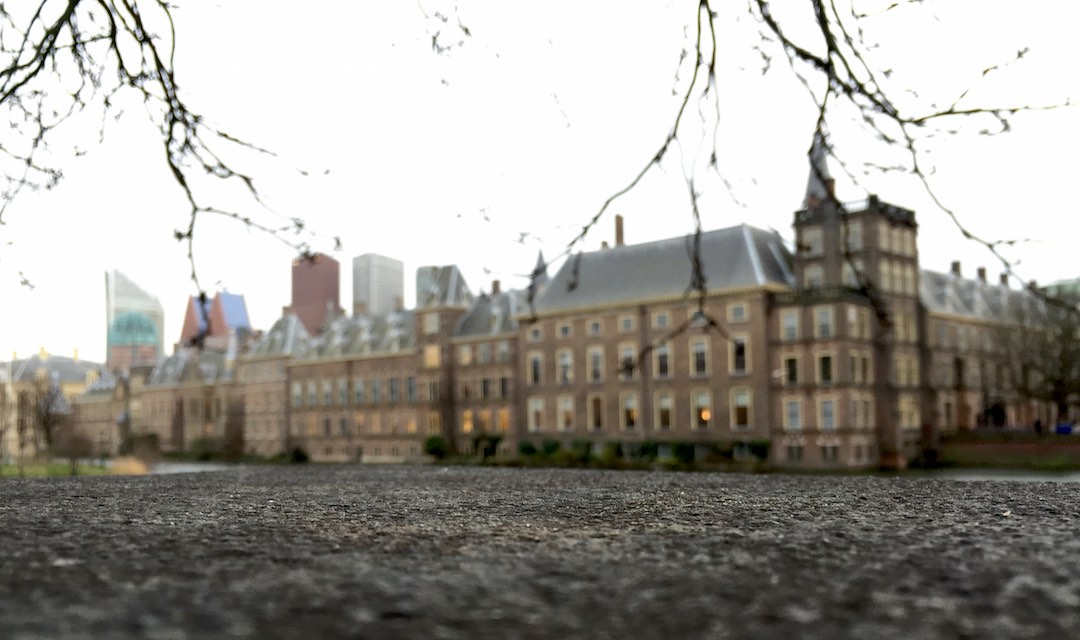
Apple replaced the mDNSResponder daemon that is responsible for DNS requests and many other network discovery functions with a new discoveryd, which is rather buggy. By installing the OS X 10.9 mDNSResponder on your 10.10 system, you'll get rid of duplicate network names, wake on demand works again and NAT mappings are created so it's possible to host services on your Mac that are reachable from the outside.
Read the article - posted 2015-01-12
Image link - posted 2015-01-13
Google has been measuring how many of its users have working IPv6 for some years now. At the beginning of 2014, this number was 2.75%; higher during weekends, lower on weekdays. We ended the year close to 6%, but then when we all went back to work in 2015, we dipped right back down below 5%!

When North Korea's connection to the global Internet stopped working last month, one particularly eye-popping detail emerged. Despite being home to 25 million people, the Hermit Kingdom has barely more than a thousand Internet protocol addresses. IP addresses are a bit like Social Security numbers, used to identify every device — from laptops to mobile phones to gaming systems — connected to the Internet. How many exist per person around the planet paints a picture of just how unevenly the Internet is distributed today.
Read the article - posted 2015-01-16
Trams, een paar bussen en een stadhuis in de mist.

Image link - posted 2015-01-24
As part of my BGP training course, I explain to the participants that they can get BGP either by buying a router from the likes of Cisco or Juniper, or by running routing software such as Zebra, Quagga or OpenBGPD on a Unix (-like) operating system. Then I always mention that I haven't tried OpenBGPD yet, but I really should.
There's no time like the present, so I decided to take the plunge today.

Yesterday, I talked about my first experience with OpenBGPD. Which of course raised the question: why not use BIRD instead? It's a lot more mature. So I gave it a try.

Over the weekend, I wrote posts about trying out OpenBGPD and BIRD.
Here's a bunch more information about these two and other open source routing software...
Read the article - posted 2015-02-02
This text used to be on the BGPexpert.com home page, but Cisco now includes "no syncronization" in the default configuration, so it's unlikely anyone is still going to run into trouble because of this, so I've moved this to a separate page out of the way.
When you run BGP on two or more routers, you need to configure internal BGP (iBGP) between all of them. If those routers are Cisco routers, they won't work very well unless you configure them with no synchronization.
Read the article - posted 2015-02-04
Image link - posted 2015-02-04
In 2013, I wrote a pretty long story with advice to podcast app developers. Today, someone on Twitter asked me if I ever found a good solution to the "catching up" use case. I guess the short answer would be "no", but did settle on a podcast listening workflow that works fairly well. So let me explain how I listen to podcasts these days.

I got two cases and converted the iPhone 5S dock to accept the iPhone 6.
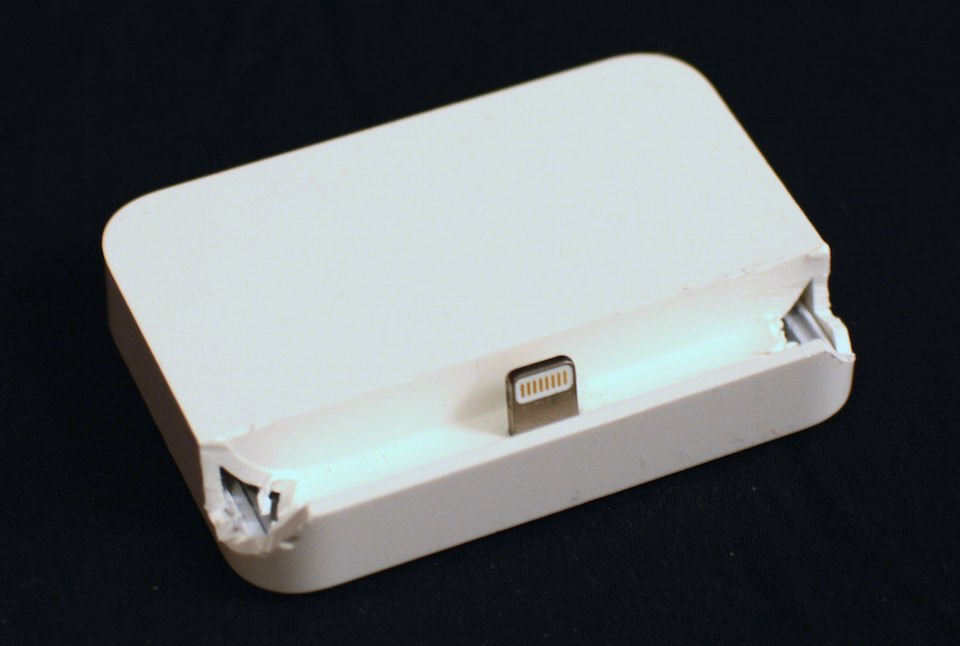
❝Or Exactly Why Apple Keeps Doing Foolish Things❞, by Bruce "Tog" Tognazzini.
We've been talking a lot about Apple's software quality recently. And for sure, there are issues there. Some people have tried to dismiss these issues by pointing out that Apple has always had buggy software. That's true. I'm not sure which MacOS version it was, but I clearly remember thinking: "please release the new OS soon; I know it's buggy but at least those will be new bugs, I'm so sick and tired of the old ones".
Obviously, doing a bad job in the past is no excuse for doing a bad job today. But it goes deeper than this: not only is Apple's software buggy, it's buggy because Apple is making changes that make no sense to us. Or worse, what we consider to be bugs is actually the functionality intended by Apple.
In this long but must-read article (that's almost two years old!), Tog explains how this came about: Apple is focussing on luring in new users at the expense of long-time users of their products.
Hopefully, the release of the Apple Watch means that Apple is mostly done with radically changing all kinds of things for a while, so the company can focus on making sure all these new and changed features work right in MacOS 10.11 and iOS 9.
Read the article - posted 2015-02-09
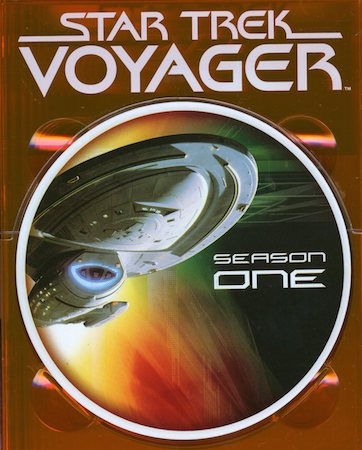 Twenty years ago, on January 16, 1995, the first episode of Star Trek Voyager was broadcast in the US. The series would be on the air for seven seasons. I'm not sure when I started watching, but I ended up buying all 172 episodes on VHS. Every Tuesday I would go to the Free Record Shop to buy a tape with two new episodes for ƒ 29,99, later € 13,61. So I must have spent 1170 euros on Voyager. I was actually about to buy that week's tape when my brother called me on my first Nokia cell phone to tell me an airplane had crashed into the World Trade Center in New York.
Twenty years ago, on January 16, 1995, the first episode of Star Trek Voyager was broadcast in the US. The series would be on the air for seven seasons. I'm not sure when I started watching, but I ended up buying all 172 episodes on VHS. Every Tuesday I would go to the Free Record Shop to buy a tape with two new episodes for ƒ 29,99, later € 13,61. So I must have spent 1170 euros on Voyager. I was actually about to buy that week's tape when my brother called me on my first Nokia cell phone to tell me an airplane had crashed into the World Trade Center in New York.
At about 250 grams a piece, this collection weighed in at 21.5 kilos, and I got rid of it when I moved to Spain. However, last week I re-bought Voyager, on DVD this time. The box set weighs 1.25 kilos and cost me € 105.
Read the article - posted 2015-02-15
The latest Apple rumor is that they're working on a car. A rumor that is easily dismissed:
The fantastic Apple Car is a fantasy.
But is it? What would it take for Apple to start making cars?
Read the article - posted 2015-02-16
Deze zaterdag rijdt de laatste trein bovengronds door Delft. Een week lang rijden er dan helemaal geen treinen, en vanaf 28 februari rijden de treinen door de nieuwe tunnel en stoppen ondergronds op het nieuwe station.
Als openbaarvervoer-fotograaf voelde ik mij uiteraard genoodzaakt foto's te maken zolang het nog kon.

So HTTP 2 multiplexes multiple transfers over a single TCP session. It would be cleaner to do this using SCTP, which implements multiple streams natively. But having to figure out whether you can use SCTP or need to use TCP would be a significant complication, while negotiating the use of HTTP 2 over TCP port 80 should be relatively straightforward.
I'm glad the mandatory encryption didn't happen. Encryption is important, but there are times where it's unneeded, and forcing people to use it when they don't want/need it would just make for even more carelessness with certificates than we're already seeing today. For instance, the server serves the exact same copy of this webpage to anyone who requests it, so there's no point in encrypting it. Encryption would just add more time consuming round trips, use more battery power, and require me to buy a certificate.
Apparently most of the browser makers are already on the case, no mention of Safari, though. I'm interested to see how much faster HTTP 2 will be in practice.
Read the article - posted 2015-02-18
Andy Ihnatko, linking to a statement from Gemalto about the alleged stealing of SIM card encryption keys:
Good lord. There’s going to be a monument to Edward Snowden some day and it had better be a damn big one.
Read the article - posted 2015-02-25
Image link - posted 2015-02-28
Great TED talk about ten myths about psychology. I especially found the one about the psychological difference between men and women interesting. Only 2% of women can throw a ball farther than the median man. The two biggest mental differences between men and women are spatial ability and language. But a third of women has better spatial ability than the median man and a third of men is better at language than the median women. That's only 17% off from being completely identical.
So it's not really a case of Mars and Venus. It's more a case of, if anything, Mars and Snickers: basically the same, but one's maybe slightly nuttier than the other.
Read the article - posted 2015-03-01
Today, I bought a new printer: a Canon PIXMA MG7550...
Read the article - posted 2015-03-03
Yesterday I wrote about my new printer, which supports IPv6. I posted a photo on Twitter with the printer's IPv6 address, and before long people attempted to print over the internet. Eventually, two succeeded.
I'm not very happy that Canon allows this by default, and doesn't give you any way to block this other than to disable IPv6 or put the printer behind a firewall.
Here's another link to that part of the story, as the title I used yesterday doesn't mention IPv6 or firewalling.
Read the article - posted 2015-03-04
Unless something really unexpected happens, Apple will further unveil the watch on Monday. I also think it's safe to assume the event will be streamed. If you're in Europe, remember that the time difference is an hour less than usual because the US will "spring forward" to daylight saving time this weekend while we'll be on winter time a few more weeks in Europe. So the event starts at 18:00 CET.
Here are some musings and predictions.
Read the article - posted 2015-03-05
A few years ago, I ordered some prints through iPhoto. I've also used other services to order prints of digital photos in the past, and those always look just as good as "real" photos, as long as the original file is of sufficient quality. But what about my new Canon PIXMA MG7550? How do photos printed using it compare to photos printed by a lab? See for yourself:

One of these is a print from the lab that Apple uses, the other was printed using the MG7550. Can you tell which is which?
Read the article - posted 2015-03-06
A week ago, Apple unveiled the new MacBook. The crazy thing about this new computer is that it only has two ports: an audio port and a USB type C port for everything else. The audio port is like the one in the MacBook Pros: it looks like a regular 3.5 mm headphone port, but it also supports iPhone-style headphones with a microphone and clicker, and with the right adapter, it does optical digital audio out.
The USB-C connector is very interesting. It's backward compatible with old USB standards at 1.5, 12 and 480 Mbps with a simple adapter cable. It also supports USB 3 and 3.1 at 5 and 10 Gbps, and should be ready for even higher speeds in the future. Like Apple's lightning connector, you can plug it in in both orientations. USB-C can deliver up to 5 amps at 12 or 20 V for a maximum of 100 Watts—in either direction. Last but not least, the USB-C port allows many non-USB protocols to be transmitted over a USB-C cable. So with the right cable, a USB-C port can be used to connect a monitor over HDMI or DisplayPort. This uses wires normally used for 5 Gbps USB connectivity. Depending on how many wires are used for the alternate protocol, the USB speed may have to fall back to 480 Mbps.
Read the article - posted 2015-03-16
Image link - posted 2015-03-21
A year and a half ago, in my review of the 2013 MacBook Pro, I wrote:
although it's great to be able to hook up two external displays, it's not so great to have to choose between the small, but high resolution internal display and the big, but low resolution external displays. I find myself working on the internal display a lot, but when I need more screen real estate I switch to the big external display. I sit relatively far from my external display, so the fuzzy pixels aren't too obvious. The high resolution display hasn't completely ruined regular displays for me, but it's certainly got me coveting an external 4k display.
4k displays have gotten pretty affordable now, do I decided to get one...
Read the article - posted 2015-03-22
After yesterday's post about the Dell P2415Q monitor, I wondered how many sheets of A4 paper fit on the screen. Answer: height-wise, it's a perfect match:

At 52 cm, you can fit almost 2.5 sheets side-by-side. Interestingly, Apple's Preview application (middle) knows the size of the screen, and PDFs zoomed to 100% are exactly the right size. Unfortunately, due to the menu bar, the title bar and toolbar, the A4 PDF won't completely fit on the screen and in full screen mode Preview zooms to 98%.
Pages (left) and Word, on the other hand, still operate under the delusion that screens have a resolution of 72 pixels/points per inch, and need to be set to about 130% zoom.
Permalink - posted 2015-03-23
I honestly thought I knew pretty much everything there is to know about Apple's Keynote presentation program. I was wrong. I didn't know this:
When you want to join two objects with a line, the easiest way to do it is to use a connection line (rather than creating a separate line as a shape). Two objects joined by a connection line remain joined even if you reposition the objects on the slide canvas.
Read the article - posted 2015-03-30
CGP Grey videos are now available in convenient video podcast form.
This is great. I love his videos, but hunting them down on Youtube is just too much work these days. With a podcast, watching/listening episodes in order (well, once you turn off all of this "newest on top" nonsense) is easy and new episodes automatically pop up. Youtube, on the other hand, seems to go out of its way to make it difficult to watch stuff in order and quickly find new stuff. Apparently, they really need you to go with the flow and just watch whatever video they feel should be next.
This is the link to the RSS feed and this the link on iTunes. Too bad the feed currently only has a single episode.
Permalink - posted 2015-03-30
Image link - posted 2015-04-02
At the RIPE-70 meeting next month in Amsterdam I'll be doing a tutorial on BGP: "Get Your Hands Dirty with BGP".
This is the "light" version of the regular BGP training that I do several times a year: the theory part will be around 30 minutes and then about two hours of hands-on BGP using the Quagga routing software running in a virtual machine on the participant's laptops.
If you're attending the RIPE meeting and you're interested in participating, please go to this page and send me an email so I know how many people to expect.
Permalink - posted 2015-04-15
Image link - posted 2015-04-18
After installing the latest version of the Intel® Power Gadget, I noticed that the GPU speed on my late-2013 13" MacBook Pro never really deviated from 0.55 GHz. (Well, except when playing high definition video, then it goes to 0.4 GHz.)
So I found these WebGL demos. It's really unbelievable what can be done in a browser these days. And yes, most of these will stress both the CPU and GPU to the max.

Read the article - posted 2015-04-25
For some years now, the Regional Internet Registries have been rolling out RPKI. The Resource Public Key Infrastructure allows holders of IP addresses to authorize an autonomous system to inject those addresses in BGP. (See here for an overview of how RPKI works and more links.)
I've always thought it would be hard to deploy RPKI in the real world, because it's just way too easy for a certificate or ROA (route origination authorization) to expire. If that then leads to routes becoming invalid and the addresses in question being unreachable, that would be a good example of the cure being worse than the disease.
Fortunately, that's not the case: RPKI is ready for real-world deployment today.
Read the article - posted 2015-04-30
I'm at the RIPE meeting in Amsterdam this week. Yesterday, one of the first presentations was one from Alcatel-Lucent's Greg Hankins: Evolution of Ethernet Speeds: What’s New and What’s Next.
Apparently, we're going to get some new Ethernet speeds in the (relatively) near future, such as 2.5, 5 and 25 Gbps. I can't wait!
Read the article - posted 2015-05-12
Lang was de benelux-intercity die tussen Amsterdam en Brussel rijdt mijn favoriete trein: omdat-ie Leiden overslaat was-ie in 25 minuten van schiphol op Den Haag HS of omgekeerd. Toen kwam de fyra en werd de benelux opgeven. En de fyra verdween weer en de benelux kwam terug. Zij het trager. Hij staat tegenwoordig zeven minuten stil in Rotterdam en rijdt nu ook via de Luchthaven Brussel, dus je bent aanzienlijk langer onderweg.
Maar 't is nog wel de snelste trein van Amsterdam Centraal naar Den Haag HS met 46 minuten volgens de dienstregeling. Vreemd genoeg staat er nu wel 31 minuten voor het stuk schiphol - Den Haag, terwijl-ie daar niet stopt. En tot Den Haag Mariahoeve rijdt-ie ook lekker door: gister passeerden we Leiden Centraal met 140 kilometer per uur!

Bij Laan van NOI zakten we af naar 45 km/u en vlak voor HS stonden we nog eventjes stil. Toch waren we een minuut voor tijd op HS en ik kon met een sprintje nog tram 12 halen en was dus in welgeteld 62 minuten van Amsterdam Centraal thuis. Zo kan het dus ook.
Permalink - posted 2015-05-14
Yesterday when I woke up, I wasn't worried at all about my fluoride levels. Then I started reading, and I became worried that I wasn't getting enough to keep my teeth healthy. After that, I read some more, and become somewhat worried I may be getting too much. All thanks to dr. Google.
Read the article - posted 2015-05-27
I felt a queazy mixture of pride and disgust as our lure zinged out into the world.
It is way too easy to get bad research published and covered in the media, especially about nutrition.
Read the article - posted 2015-05-29
I'll spare you the details, but I recently needed to up my game in the toothbrushing department. I've been brushing my teeth with an entry-level Oral-B electric toothbrush for almost a decade, but I thought I could do better with a more advanced one that provides a warning when you brush too hard. (This can damage your gums.) Turns out there's now a model that has bluetooth. After all, everything is better with bluetooth.
Read the article - posted 2015-05-29
Allen Pike, "crafter of fine software", writes about how insane browser user agent strings have gotten. Case in point, the mobile version of Edge, Microsoft's new cutting-edge browser:
Mozilla/5.0 (Windows Phone 10.0; Android 4.2.1; DEVICE INFO) AppleWebKit/537.36 (KHTML, like Gecko) Chrome/39.0.2171.71 Mobile Safari/537.36 Edge/12.0That is to say, Microsoft Edge claims to be every computing platform ever conceived - except for Internet Explorer.
The nasty thing with all this useless nonsense that the browser sends to the server for every request is that it takes up often precious upstream bandwidth. On a slow DSL or 3G link this can really slow things down.
Read the article - posted 2015-05-31
A while back, I gave my sister a 1 TB 2.5" USB HDD for backing up her Mac using Time Machine. But somehow she couldn't perform backups anymore lately. The drive contained two volumes: a regular one and an encrypted one. The regular one wouldn't mount and Disk Utility wouldn't repair it.
No big deal, just wipe the drive and start from scratch, I thought—assuming it's not a hardware problem. That was easier said than done. I ended up spending half the day yesterday just trying to repartition that stupid USB drive.
Read the article - posted 2015-05-31
Image link - posted 2015-06-03
Alles in het leven is tegenwoordig digitaal, maar de radio is eigenlijk niet veranderd sinds de invoering van FM in de jaren '50. Maar als we dit promotiefilmpje van een jaar geleden mogen geloven is de radio nu ook hard op weg om digitaal te worden! Dat wilde ik zelf wel eens horen, dus gister heb ik mijn eerste digitale radio gekocht.
Read the article - posted 2015-06-04
I think yesterday's WWDC was the longest one I've seen at nearly 2.5 hours. Still, there wasn't much to get excited about. Apple Pay is coming to the UK, but not to the rest of the world. Apple Maps transit directions are coming to two handfuls of cities and all of China, but not to Holland. Apple's new news app is also limited to the US, the UK and Australia. The music stuff may or may not be interesting, but I'm afraid it's going to get in the way of simply playing the music I have on my computer and my iPhone.
But... reading the fine print, there is one thing I can get behind:
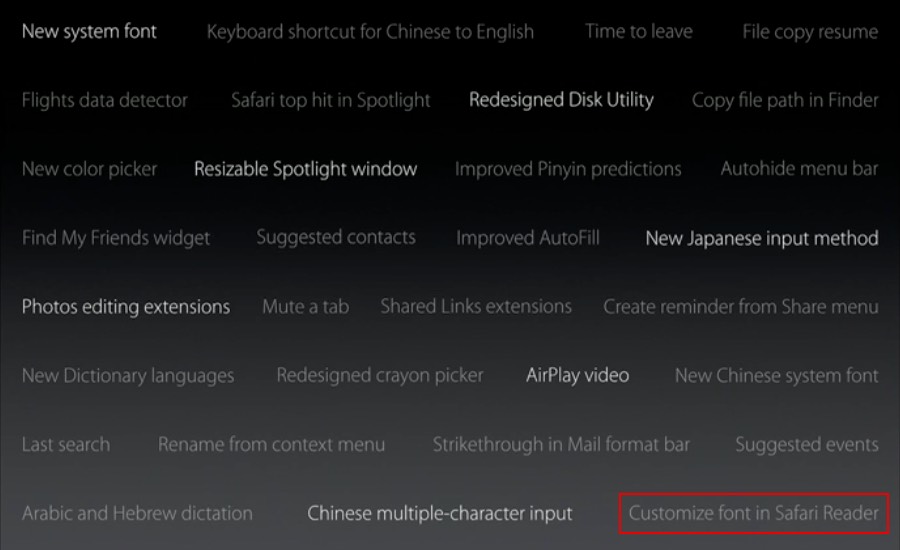
A customizable font for Safari Reader!
I must be getting old, but I really can't stand what the web has become these days. The trend to have fixed banners at the top and/or bottom of pages gets on my nerves, because that way you can't scroll a webpage one screen at a time. It's also visually distracting. As are the attention-grabbing ads, which are often animated or video. So there's hardly any text I read on the web without invoking Safari Reader.
However, Safari Reader itself isn't all that great: the width of the text is fixed, so in order to get avoid having too many words per line, which makes it hard to land on the next line, I need to keep the text size bigger than I'd like. (Funny, because 95% of web pages use text that is way too small.)
Safari Reader uses the Georgia font, which isn't terrible, but largish serif fonts just don't take advantage of high resolution displays. So I hope that in addition to the ability to configure a nice sans serif font, we also get to adjust the margins in Safari Reader.
Permalink - posted 2015-06-09
During last week's WWDC, Apple announced that it will start requiring iOS 9 apps to support IPv6. The reason for this is that cell carriers want to move from dual stack to IPv6-only cellular data service, with NAT64 to let users reach IPv4 destinations. This only works if apps use IPv6-compatible APIs and don't do things like checking for the availability of (IPv4) internet connectivity or using IPv4 addresses directly, rather than DNS names.
The article links to a WWDC video that explains all of this in detail, and then continues with some other very interesting information on network performance issues, including the fact that Apple is turning on Explicit Congestion Notification (ECN) in the new versions of MacOS and iOS. Microsoft tried to do the same thing in Vista, but had to turn it back off because too many firewalls blocked packets with ECN. Hopefully that's no longer an issue seven years later.
Read the article - posted 2015-06-16
At the NANOG meeting in San Francisco two weeks ago, there was a session on The benefits of deploying IPv6 only. Someone from T-Mobile explained that the latest Windows Mobile and Android support 464XLAT to allow IPv4-only applications to work over IPv6 with NAT64, so those devices now only get IPv6. Other devices only get IPv4, there's no dual stack. At that point, the panelists didn't know yet that Apple is requiring iOS 9 apps to work over IPv6 so those can work through NAT64 without 464XLAT.
Another interesting data point is the observation by Facebook that IPv6 tends to perform better than IPv4, with the margin being as large as 40%:
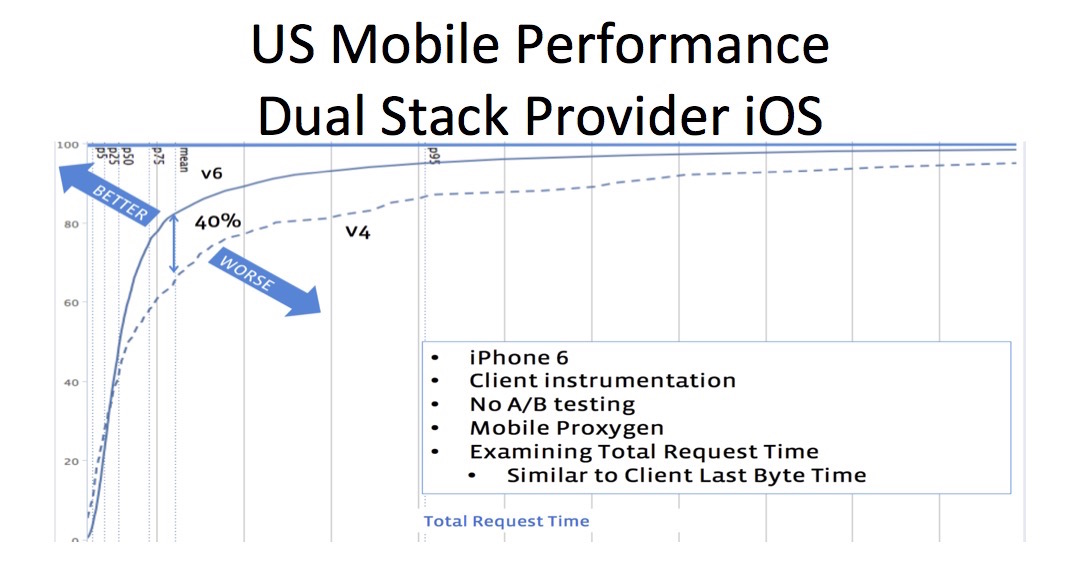
However, why this is is unclear: the RTTs are the same, yet the performance/bandwidth over IPv6 is better. There was some frustration because Apple's implementation of "happy eyeballs" only looks at the RTT to choose between IPv4 and IPv6, and thus lands on IPv4 a good deal of the time and doesn't enjoy the benefits of that better IPv6 performance.
Permalink - posted 2015-06-17
Image link - posted 2015-06-17
Despite the blister on my foot I couldn't resist going out and trying out my new Powerslide Fothon wheels for my inline skates. I got a 4-pack of wheels with red LEDs:
The wheels contain a small generator that uses the rotation of the wheel to generate electricity for the LEDs, so they come on when the wheels turn. Because all of this slows down the wheels a bit, I'm only using one on each skate. They also come in white, blue and green.
And as always, iPhone slow motion video for the win!
Permalink - posted 2015-07-03
This July 30th, at 23:59:60, a leap second was added to Coordinated Universal Time (UTC). Dyn Research posted the following graph on Twitter that shows there was significant BGP update instability for five minutes after the leap second occurred:

Rond 1990, 1991 was ik vrijwilliger bij Lokatel, de lokale omroep in Den Haag. Lokatel had geloof ik iets van tweehonderd vrijwilligers en een handjevol betaalde krachten. Ik heb een enkele keer wat voor de radio en de televisie gedaan, maar ik was voornamelijk bezig met de kabelkrant.
In die tijd voor het World Wide Web hadden we wel teletekst, maar dat was nog niet zo ingeburgerd als het later zou worden. Bovendien zijn de grafische mogelijkheden van teletekst beperkt. Vandaar dat in die jaren het medium kabelkrant een zekere populariteit had. Een kabelkrant bestond uit een verzameling pagina's die één voor één in beeld kwamen op een (kabel-) televisiekanaal.
Ik vond nog een oude VHS-band terug met een stukje van de Lokatel Kabelkrant uit november of december 1989. Klik op het plaatje om naar de volgende pagina te gaan.
En ik ben reuze benieuwd welke Lokatelli's er straks allemaal naar de Lokatel-reünie in de bibliotheek/stadhuis gaan.
Permalink - posted 2015-07-08
As we learned last month, Apple has included a DNS64/NAT64 implementation in the upcoming version 10.11 of the Mac operating system, for the purpose of testing whether iOS applications are "IPv6-clean". I installed the public beta of 10.11 last week, so I was able to see how this DNS64/NAT64 implementation works.
Read the article - posted 2015-07-13
De Utrecht Skate Parade ging deze vrijdag naar Kasteel De Haar buiten de stad. Goede reden om naar Utrecht te gaan en mee te rollen! De route was met ruim 27 kilometer iets langer dan normaal, en ik begrijp dat er 350 mensen meededen.
Deze keer durfde ik voor het eerst een camera mee te nemen, dus hier een aantal foto's.

Een jaar geleden heb ik inline skates gekocht, en sindsdien heb ik flink wat kilometers op acht wielen afgelegd, zowel op eigen houtje als in georganiseerde tochten. In een aantal steden wordt op vrijdagavond onder de titel Friday Night Skate gereden, en dan zijn er nog een paar plaatsen waar op andere avonden of overdag getoerd wordt. Hier een overzicht. (Dus sorry, de titel dekt de inhoud niet volledig!)

Image link - posted 2015-07-29
After reading stuff like this and even like this, I'm so glad I didn't sign up for Apple's new music service.
Read the article - posted 2015-07-30
20 years ago today, I got my first autonomous system (AS) number, marking my entry in the BGP business. (5399, if you're wondering.)

To quote Ferris Bueller: "Life moves pretty fast. If you don't stop and look around once in a while, you could miss it." So let's look back and see what has happened over those 20 years.
Read the article - posted 2015-08-15
Image link - posted 2015-08-26

Het begon allemaal zo goed met zelfs nog hier en daar wat zon maar niet lang na de tweede pauze kwamen er toch wat druppels naar beneden... Hier 66 foto's.
Read the article - posted 2015-09-13
Nine months ago I got myself the entire series of Star Trek Voyager on DVD. Today, I watched the series finale. Usually those suck, but this one was pretty good! It did provide some closure but not at the cost of being an entertaining episode in its own right with plenty of action.
Read the article - posted 2015-09-20
Image link - posted 2015-09-23
If you liked (or missed) last month's post where I talk about 20 years of BGP, you may be interested in this story for the RouterFreak site that covers the history of inter-domain routing all the way from the GGP protocol in the early 1980s to the present.
Read the article - posted 2015-09-24
Image link - posted 2015-10-04

It's been a while since I wrote about photography. But I got another toy the other day, and I have a lot to say about it! So be warned, this could get a bit long. The new toy in question is a Nikon SB-700 "speedlight". What we regular people would call an external flash unit, or simply "a flash".
Read the article - posted 2015-10-08
There have been rumors for a while that Apple would be releasing new keyboards and/or mice and/or trackpads soon. The rumors were right: a week or two ago they released all three. I had actually been waiting for the new keyboards because the Apple wireless keyboard I got in 2008 no longer wants to pair with anything. So that one is a paperweight now. The big white one introduced in 2003 that I also have still works, but that one won't talk to iPhones or Apple TVs.
So enter the new keyboard, mouse, trackpad. So I went to www.apple.nl to check them out. And nearly fell off of my chair as I saw the prices: € 120 for the keyboard, € 90 for the mouse and € 150 for the trackpad. So that's 360 euros for all three. For 20 euros more you can buy a Dell Inspiron 15 3000 laptop!
To add insult to injury, the new laptop really isn't very good from the looks of it. I've heard some people comment that the new full-size left and right cursor keys are actually worse than the old half-height ones because now they're harder to identify by touch. The key travel is also quite shallow, shallower than that of the old one, I believe.
None of this would be a deal breaker by itself, as was looking for an extra keyboard, as I already have a big IBM Model M that covers my daily typing needs.
I had heard about Logitech bluetooth keyboards that will let you switch between three different paired devices quickly and easily before: the Logitech K810 illuminated keyboard for Windows and the Logitech K811 for the Mac. These get rave reviews. The K811 looks a lot like Apple's wireless keyboard, but adds backlighting like Apple's laptop keyboards have. At around 100 euros, this already looked like a much better deal than Apple's new wireless keyboard.
But it turns out there's now also the Logitech K380 multi-device keyboard. I got mine for € 50.

Een paar maanden geleden heb ik een DAB- (digital audio broadcasting) radio gekocht. Ik heb toen geschreven over hoe die beviel, maar één aspect had ik nog niet echt onder de loep genomen: de audiokwaliteit.
Read the article - posted 2015-10-25
Vrijdag 30 oktober was de Friday Night Skate een stuk enger dan normaal met veel van de deelnemers verkleed in griezelige kostuums.
"Laat de toeristen schrikken!"

Image link - posted 2015-10-31
If you've used a camera in the past decade or two, you know the drill: half-press the shutter button and the camera focuses, then press the shutter all the way to take the photo. Should you find yourself second guessing the autofocus system, then you can flip a switch or go into a menu to turn off autofocus (AF) and manually focus (MF) using the lens' focus ring instead. With a single lens reflex camera you'll have a dot in the viewfinder that tells you AF or MF has been achieved successfully. If not, the Nikon D7100 has a couple of extra indicators next to the focus confirmation dot that tell you in which direction you need to turn the focus ring to achieve focus.
For some types of photography, such as close-up / macro or astrophotography, you may find yourself switching to autofocus and manual focus quite often. I'm here to tell you there is a better way: back button focus.
Read the article - posted 2015-11-08
Image link - posted 2015-11-12

I wanted to try out my new 55-200 mm lens, so I went to see the arrival of Sinterklaas at the Scheveningen harbor. Here in Holland Sinterklaas is a big deal (read about it on Wikipedia), I didn't quite realize how big a deal until I saw all these thousands of kids that came to see his arrival. Of course our mayor Jozias van Aartsen welcomed Saint-Nicolas.
Hold on to your hat, Sinterklaas, it's pretty windy!
Read the article - posted 2015-11-14

My review of iWork '15 for Ars Technica.
Read the article - posted 2015-11-17
I couldn't help myself and bought yet another lens a couple of weeks ago. It's the Nikon 55-200 mm VR II. It's a small and cheap tele lens for Nikon DX digital SLRs, and I'll be talking about it some more soon. What I want to do today is look at how good the vibration reduction works.
Read the article - posted 2015-11-23
These are the top 10 internet exchanges in the world exchanging the most traffic according to Packet Clearing House:

As you can see, the DE-CIX in Frankfurt is the top dog at 4.76 terabits per second peak traffic. (That's enough to transfer about a hundred HD movies or 595 gigabytes per second.) The Amsterdam Internet Exchange is second at 3.94 Tbps. But... we also have the Neutral Internet Exchange (NL-ix) in Amsterdam at 1.44 Tbps. So AMS-IX and NL-ix together make Amsterdam the city with the most internet traffic in the world at no less than 5.38 Tbps as per these statistics.
Congrats, Amsterdam!
However, not all NL-ix traffic is actually exchanged in Amsterdam, they have many locations in the Netherlands and also some in the surrounding countries. It's still entirely possible that at least 830 Gbps of that 1.44 Tbps is exchanged in Amsterdam, though.
Permalink - posted 2015-11-27
A year and a half ago I waxed poetically about the small size and the weight of Nikon's latest collapsible version of their cheap 18-55 mm lens, as you can read in my review. However, since then I've also bought the bigger and heavier 16-85 mm lens, which covers a more convenient zoom range. And then I found out that Nikon upgraded its other cheap kit lens to be collapsible: the 55-200 mm one. So I bought that one as well.

So now I have two sets of consumer normal zoom + tele zoom lenses: the collapsible 18-55 and 55-200 and the more upscale, but still consumer-territory 16-85 and 70-300 mm lenses. So I thought I'd compare them.
Read the article - posted 2015-11-28
Image link - posted 2015-12-05
Earlier this year I already talked about the switch to USB-C. But I have more to say about the subject, especially regarding the MacBook Pro. This was also posted on the Ars Technica forums.
Read the article - posted 2015-12-06
Image link - posted 2015-12-07
Image link - posted 2015-12-24